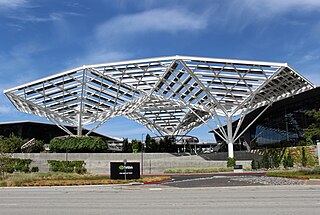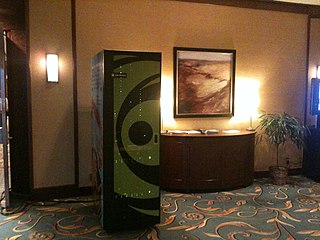
Nvidia Corporation is an American multinational corporation and technology company headquartered in Santa Clara, California, and incorporated in Delaware. It is a software and fabless company which designs and supplies graphics processing units (GPUs), application programming interfaces (APIs) for data science and high-performance computing, as well as system on a chip units (SoCs) for the mobile computing and automotive market. Nvidia is also a dominant supplier of artificial intelligence (AI) hardware and software.

Db2 is a family of data management products, including database servers, developed by IBM. It initially supported the relational model, but was extended to support object–relational features and non-relational structures like JSON and XML. The brand name was originally styled as DB2 until 2017, when it changed to its present form.
Teradata Corporation is an American software company that provides cloud database and analytics-related software, products, and services. The company was formed in 1979 in Brentwood, California, as a collaboration between researchers at Caltech and Citibank's advanced technology group.

A graphics processing unit (GPU) is a specialized electronic circuit initially designed to accelerate computer graphics and image processing. After their initial design, GPUs were found to be useful for non-graphic calculations involving embarrassingly parallel problems due to their parallel structure. Other non-graphical uses include the training of neural networks and cryptocurrency mining.
General-purpose computing on graphics processing units is the use of a graphics processing unit (GPU), which typically handles computation only for computer graphics, to perform computation in applications traditionally handled by the central processing unit (CPU). The use of multiple video cards in one computer, or large numbers of graphics chips, further parallelizes the already parallel nature of graphics processing.
In computer science, stream processing is a programming paradigm which views streams, or sequences of events in time, as the central input and output objects of computation. Stream processing encompasses dataflow programming, reactive programming, and distributed data processing. Stream processing systems aim to expose parallel processing for data streams and rely on streaming algorithms for efficient implementation. The software stack for these systems includes components such as programming models and query languages, for expressing computation; stream management systems, for distribution and scheduling; and hardware components for acceleration including floating-point units, graphics processing units, and field-programmable gate arrays.

IBM Netezza is a subsidiary of American technology company IBM that designs and markets high-performance data warehouse appliances and advanced analytics applications for the most demanding analytic uses including enterprise data warehousing, business intelligence, predictive analytics and business continuity planning.

Greenplum is a big data technology based on MPP architecture and the Postgres open source database technology. The technology was created by a company of the same name headquartered in San Mateo, California around 2005. Greenplum was acquired by EMC Corporation in July 2010.

Vertica is an analytic database management software company. Vertica was founded in 2005 by the database researcher Michael Stonebraker with Andrew Palmer as the founding CEO. Ralph Breslauer and Christopher P. Lynch served as CEOs later on.
HPCC, also known as DAS, is an open source, data-intensive computing system platform developed by LexisNexis Risk Solutions. The HPCC platform incorporates a software architecture implemented on commodity computing clusters to provide high-performance, data-parallel processing for applications utilizing big data. The HPCC platform includes system configurations to support both parallel batch data processing (Thor) and high-performance online query applications using indexed data files (Roxie). The HPCC platform also includes a data-centric declarative programming language for parallel data processing called ECL.
InfiniteGraph is a distributed graph database implemented in Java and C++ and is from a class of NOSQL database technologies that focus on graph data structures. Developers use InfiniteGraph to find useful and often hidden relationships in highly connected, complex big data sets. InfiniteGraph is cross-platform, scalable, cloud-enabled, and is designed to handle very high throughput.

Actian Vector is an SQL relational database management system designed for high performance in analytical database applications. It published record breaking results on the Transaction Processing Performance Council's TPC-H benchmark for database sizes of 100 GB, 300 GB, 1 TB and 3 TB on non-clustered hardware.

Nvidia Tesla is the former name for a line of products developed by Nvidia targeted at stream processing or general-purpose graphics processing units (GPGPU), named after pioneering electrical engineer Nikola Tesla. Its products began using GPUs from the G80 series, and have continued to accompany the release of new chips. They are programmable using the CUDA or OpenCL APIs.

NVLink is a wire-based serial multi-lane near-range communications link developed by Nvidia. Unlike PCI Express, a device can consist of multiple NVLinks, and devices use mesh networking to communicate instead of a central hub. The protocol was first announced in March 2014 and uses a proprietary high-speed signaling interconnect (NVHS).
Kinetica is a distributed, memory-first OLAP database developed by Kinetica DB, Inc. Kinetica is designed to use GPUs and modern vector processors to improve performance on complex queries across large volumes of real-time data. Kinetica is well suited for analytics on streaming geospatial and temporal data.
Presto is a distributed query engine for big data using the SQL query language. Its architecture allows users to query data sources such as Hadoop, Cassandra, Kafka, AWS S3, Alluxio, MySQL, MongoDB and Teradata, and allows use of multiple data sources within a query. Presto is community-driven open-source software released under the Apache License.
HEAVY.AI is an American-based software company, that uses graphics processing units (GPUs) and central processing units (CPUs) to query and visualize big data. The company was founded in 2013 by Todd Mostak and Thomas Graham and is headquartered in San Francisco, California.
Ampere is the codename for a graphics processing unit (GPU) microarchitecture developed by Nvidia as the successor to both the Volta and Turing architectures. It was officially announced on May 14, 2020 and is named after French mathematician and physicist André-Marie Ampère.
Nvidia GTC is a global artificial intelligence (AI) conference for developers that brings together developers, engineers, researchers, inventors, and IT professionals. Topics focus on AI, computer graphics, data science, machine learning and autonomous machines. Each conference begins with a keynote from Nvidia CEO and founder Jensen Huang, followed by a variety of sessions and talks with experts from around the world.
Blackwell is a graphics processing unit (GPU) microarchitecture developed by Nvidia as the successor to the Hopper and Ada Lovelace microarchitectures.









